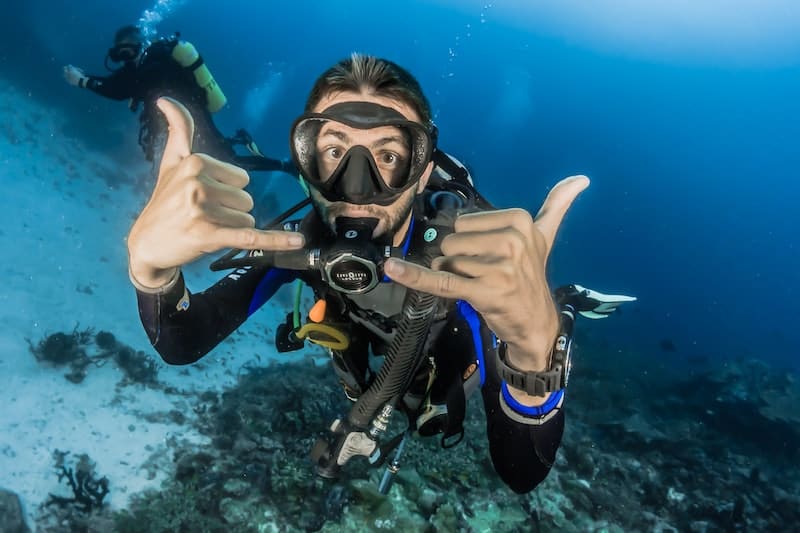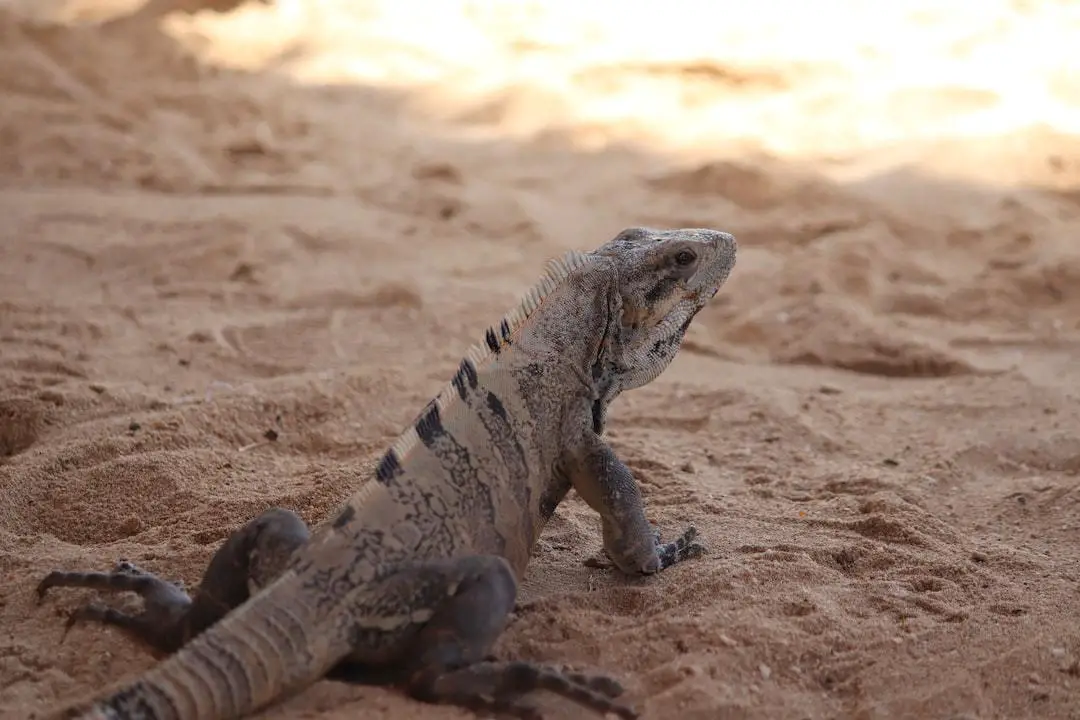
If you’ve been to Cancún or any Mexican beaches in the past few years, then you’ve seen the influx of stinky seaweed washed up on the shore. Record amounts of sargassum bombarded the beaches in 2018 and 2019. So how are the beaches looking this year?
Is there still seaweed in Cancún? 2020 is expected to be a milder year for sargassum than 2018 or 2019. However, there will still be some seaweed on the beaches of Cancún this year.
Resorts and hotels are working hard to clean up the beaches and keep the seaweed from ever reaching the shore. But chances are if you visit Cancún this year you will still see plenty of sargassum. Today we’re going to go through everything that you need to know about sargassum seaweed so that you can be prepared and protect yourself.
First, What Is Sargassum Seaweed?
Christopher Columbus first identified large floating masses of sargassum seaweed in the Atlantic Ocean in the 15th century. Today sargassum is abundant, especially in places like Cancún, Mexico.
Sargassum is a type of seaweed that is typically brown or brown and yellow. It consists of branches and leafy appendages with grape-like round structures. The grapes are called pneumatocysts. They are gas-filled pockets, mostly containing oxygen. Those pneumatocysts make the algae buoyant, allowing it to float on the water’s surface.
Once the sargassum loses its buoyancy, it sinks to the floor of the ocean. When this happens, the sargassum provides fuel in the form of carbon to deep-sea fish. It is an essential part of the ecosystem.
According to NOAA, “Floating rafts of sargassum can stretch for miles across the ocean. This floating habitat provides food, refuge, and breeding grounds for an array of animals such as fishes, sea turtles, marine birds, crabs, shrimp, and more.”
Many animals live their whole lives in the sargassum habitat. Fish like jacks, mahi-mahi, and amberjacks use the floating seaweed as a primary nursery.
Thanks in large part to pollution and climate change, these large mats of sargassum are bombarding beaches in Mexico. The problem is that the sargassum can be very thick and unsightly for tourists. It can also be dangerous to animals like sea turtles and dolphins. But even more than just being an eyesore, it smells awful. And it can pose a health risk to humans.
Where Does Sargassum Come From?
Sargassum seaweed comes from a two million square mile area in the Northern Atlantic Ocean called the Sargasso Sea. The Sargasso Sea is the world’s only ocean that is not bordered by land. Instead, it is bordered by currents.
There are many different types of seaweed or algae floating in oceans all over the world. But the Sargasso Sea is unique because it harbors species of sargassum that are not only free-floating but are also capable of reproducing on the open water. Most other seaweeds originate and reproduce on the floor of the ocean.
There are two different species of sargassum found in the Sargasso Sea: sargassum natans and sargassum fluitans, which likely originates in the Caribbean. Both regenerate themselves by breaking off into smaller pieces. Small seaweed cells can regenerate into an entirely functioning plant.
It was once believed that the Sargasso Sea was covered entirely by sargassum. But the coverage is not complete. Instead, there are massive rafts of seaweed (it can be miles long and wide) widely spaced out floating in the area.
There are some areas of the Sargasso Sea where the sargassum is so prevalent that it looks like large islands. However, there are other areas where very few plants are present.
NOAA says that many endangered animals pass through the Sargasso Sea. Eels, white marlin, dolphinfish, birds, tuna, and humpback whales are just some of the creatures that get their food from the sargassum in the Sargasso Sea.
Many creatures that generally live near the coast like crabs, shrimp, fish, and worms use sargassum as their home in open waters. Some of them have evolved with the seaweed and adopted its color for camouflage. The sargassum fish uses its fins to navigate through the mass of seaweed.
So Is There Still Sargassum in Cancún in 2020?
Forecasts suggest that 2020 will be an average year when it comes to sargassum washing up on the beaches in Cancún. This year the University of South Florida put out a report based on current measurements and maps from its Laboratory of Optical Oceanography. The report says,
“The maps show with warm colors the high abundance of sargassum, confirming a drastic change since January this year in which the amount of the macroalgae in the Gulf of Mexico, the Florida Strait and the Caribbean Sea reached an amount similar to the January 2017 (1.0 million tons) and well below January 2015 (1.7 million) January 2018 (6.4 million) or January 2019 (5.0 million). “
USF, along with NASA, believe that Cancún will experience sargassum in moderate amounts from March to May 2020. The situation will likely continue into the summer months. The bloom intensity is expected to be similar to what we saw in 2017.
Most of the resort areas in Cancún have machines and people that clean up the seaweed from the beaches daily. But you shouldn’t be surprised if you see some sargassum along the shore this year.
If you are planning a trip to Cancún in 2020, you can monitor the seaweed with this live beach webcam. Here is another cam that you can use before leaving for your trip.
You can also check Facebook pages like this one where thousands of users post videos and pictures of the beach conditions.
What Is Cancún Doing to Clean up the Seaweed on the Beaches?
As I just said, some beaches use machines to rake up all the sargassum. But the problem with heavy machines is that they can ruin the natural habitats of marine animals like sea turtles. So many resorts and hotels on the coast use humans to clean up the seaweed that has washed ashore.
Beyond picking up the sargassum once it’s on the beach, Cancún is also using preventative measures like boons and boats offshore to keep the seaweed from ever reaching the beach.
Governor Carlos Joaquin says that Cancún will be ready for the sargassum season this year. According to the governor, 13,000 feet of barriers and boats will be in place by April to catch the seaweed at the peak period.
What Is That Awful Smell?
Once the sargassum washes ashore, it quickly begins to decompose. As it rots, it releases hydrogen sulfide, which smells like nasty rotten eggs. When there are large amounts of sargassum on the beach, the hydrogen sulfide emissions can rise to concentrations that are unsafe for beachgoers.
What Causes the Increase in Sargassum on Cancún Beaches?
The massive increase in sargassum in recent years is caused primarily by two things: climate change and the deforestation of the Amazon.
Sargassum thrives in warmer water. That means that even slight increases in water temperatures will fuel growth. The oceans are warming along with the planet. And that creates better conditions for the seaweed to grow in.
The other contributing factor is the deforestation of the Amazon. Over the past five years, the land next to the river has been aggressively cleared to make room for farming. Unfortunately, the soil there is poor quality, which means that farmers have to use much fertilizer.
The fertilizer then washes into the river and eventually dumps into the Atlantic Ocean. And that fertilizer then feeds the growing seaweed blooms.
We can see in satellite images that large patches of sargassum are present at the mouth of the Amazon. It then spreads across the Atlantic. It has become so prevalent that there is now a 5,592 mile-long blob of seaweed called the Great Atlantic Sargassum Belt.
The GASB extends from West Africa to the Gulf of Mexico and the Caribbean Sea. Ocean currents and wind then push the sargassum ashore. So much so that it is now affecting tourism in places like Cancún and South Florida. People just don’t seem to enjoy vacationing with a bunch of rotting stinky seaweed. Imagine that.
Are There Any Health Risks Associated with Sargassum?
As we’ve discussed, sargassum smells like disgusting rotten eggs when it decomposes on the beach. The smell is not only bothersome, but it can also be dangerous. Remember that as the seaweed rots on the beach, it produces large amounts of hydrogen sulfide. Inhaling the toxic gas can cause shortness of breath, heart palpitations, vertigo, dizziness, and headaches.
In addition to the hydrogen sulfide, the seaweed also releases ammonia. When you breathe in these two gasses, it can cause respiratory and neurocognitive symptoms in people. They can irritate your nose, eyes, and throat. And this can be a particularly severe issue if you have any breathing illnesses.
If you are sensitive to hydrogen sulfide, you may have difficulty breathing after you inhale it.
The toxic exposure happens around 48 hours after the sargassum washes ashore. Reuters reports that more than 11,000 cases of acute sargassum toxicity were found on just the islands of Guadeloupe and Martinique over an eight-month timeframe in 2018.
According to the United States Department of Labor, some people breathed in so much hydrogen sulfide that they became unconscious. After waking, these people reported headaches and poor memory and motor function. In addition, people complained about problems with their cardiovascular systems after they were exposed to high levels of toxic gas.
How sick the sargassum makes you will differ from person to person.
There is currently no specific treatment for sargassum toxicity. Generally, doctors must diagnose the symptoms’ source by ruling out all other possibilities. But even with the challenges, you should still seek medical attention if you have been exposed to sargassum and feel sick. The best thing you can do is to avoid exposure to the seaweed altogether.
If you are planning on traveling to Cancún, you should ask your hotel and tour operators to be transparent about the severity of sargassum in the area.
Does Sargassum Sting the Skin or Cause Blisters?
Sargassum seaweed itself won’t sting you or cause blisters. However, there are often tiny organisms living in the sargassum that do bite or sting, like the larvae or tentacles of jellyfish, for example.
It’s best to stay away from the seaweed. Once it’s decomposing on the shore, it’s dangerous because of the toxic gasses it emits. But even when it’s out in the water, you still don’t want to touch it because you could end up with skin irritations.
Can You Eat Sargassum?
While some people believe that you can safely eat sargassum, it is generally not recommended.
The biggest problem with ingesting sargassum seaweed is that it could contain substantial amounts of heavy metals. Arsenic and cadmium are two of the most prevalent.
In recent studies, samples were taken from sargassum on the beaches of Cancún. Researchers found that the samples had arsenic levels that were 60 percent higher than what is permitted in human food. They also found heavy metal levels at an eye-popping 120 parts per million.
For these reasons, you shouldn’t cook with or eat sargassum.
Is It Safe to Swim with Sargassum?
As we just discussed, the sargassum itself won’t bite or sting you. But it is full of tiny organisms that can. It won’t hurt you to swim around it. Just be careful that you don’t touch it.
Ways to Protect Yourself and Your Family from Exposure to Sargassum
- Don’t leave children unsupervised at the beach
- If you live near the beach, keep your doors and windows shut
- Don’t touch or swim near seaweed to avoid being bit or stung by organisms living in it
- If you must come into contact with the sargassum, use gloves
- If you are experiencing symptoms after breathing the hydrogen sulfide, leave the beach until your symptoms go away
- You should limit your time at the beach if you have respiratory problems or asthma
Is There an Upside to Having Sargassum on the Beach?
As we’ve been discussing here today, sargassum can be anything from a mild annoyance to a dangerous health risk. There are many reasons that you should try to avoid it completely.
But the news about sargassum isn’t all bad.
Small amounts of it can be very good for a healthy beach ecosystem. The sargassum provides food and a habitat for many small organisms that live on the sand. It also helps to feed shorebirds. And on top of that, it helps to reduce beach erosion.
The problems arise when there are large amounts of it like there has been in recent years. Too much of this seaweed can have the effect of smothering organisms. It can prevent animals like dolphins from being able to reach the surface for a breath of air. Too much sargassum can also ruin sea turtle nesting sites.
Moderation is the key. We say this about many things in life, and it holds true for a balanced beach ecosystem when it comes to sargassum.
Increased Levels of Sargassum May Be the New Normal on Cancún Beaches
Because of climate change and warming ocean waters, sargassum is flourishing. It is moving onshore in massive amounts because of the changing wind patterns. Those wind patterns are being affected by a warmer climate. That means that the seaweed is being moved from the areas where it has typically stayed. And it is being brought further and further south.
The ocean currents are affected by the wind, and the changes in the wind are a result of changes in the atmosphere and circulation and solar heating.
These things aren’t going to change any time soon. So you can look forward to more years of above average cumulation of sargassum on beaches in Cancún. The truth is, it’s probably going to get worse.
The Bottom Line
Sargassum on the beaches of Cancún is likely something that we will have to live with. For most people, it will just be a mild annoyance, but for others, it can be downright dangerous. The best thing you can do is to stay away from it. The rotten eggs smell is something that you’ll notice, but if you steer clear of the seaweed, the toxic hydrogen sulfide won’t hurt you because there is plenty of ventilation on the beach.
If you do touch the sargassum, it’s best to wear gloves and a mask.
The peak season for sargassum is from April to August. This year the bloom magnitude is projected to be lower than it was in 2015, 2018, and 2019. However, Cancún is still expecting considerable amounts of seaweed to reach its shores in 2020.
You can protect yourself by checking ahead of time how the beaches look. Most resorts and hotels in Cancún clean up the beaches daily. And they have placed barriers and boats offshore to keep the sargassum from ever reaching the shore.
Sources
Ocean Exploration and Research
The University of South Florida




